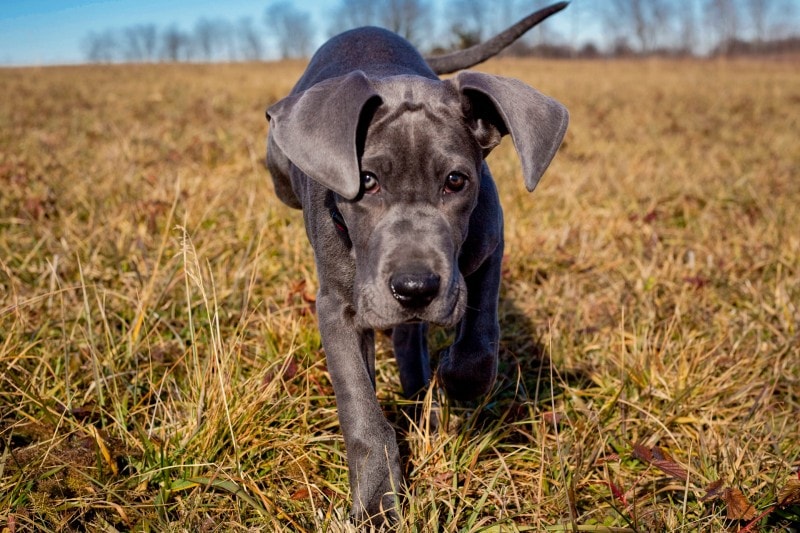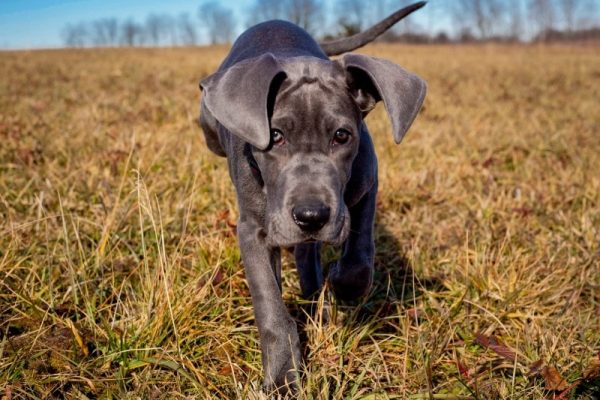Click Below to Skip Ahead
The miniature Great Dane technically isn’t its own breed, but you can find a miniature Great Dane if two runts breed together or if the Great Dane has a medical condition called dwarfism.
Breed Overview
Height:
20–26 inches
Weight:
80–100 pounds
Lifespan:
8–9 years
Colors:
Black, black and white, blue, brindle, fawn, harlequin, merle, silver, white, and mantle
Suitable for:
Families, multi-pet homes, experienced dog owners, and both city and country dwellers
Temperament:
Loyal, loving, gentle, sociable, protective, and eager to please
There are a lot of misconceptions out there about the miniature Great Dane, but the truth surrounding this breed is just as interesting! You shouldn’t find any breeders selectively breeding miniature Great Danes, but if you do happen to stumble across one, they make an outstanding pet, even if they are prone to extra medical problems.
They’re great family dogs, they do well in cities and in the countryside, and you’re not going to find a more loyal and eager-to-please pup. Just don’t let the miniature name fool you, a “miniature” Great Dane is still larger than most other full-sized dog breeds!
Miniature Great Dane Puppies
Miniature Great Dane puppies are almost identical to regular Great Dane puppies as far as their temperament goes. You can therefore expect relatively active little dogs, but not over the top with exercise requirements. Too much activity can even be damaging to their long-term health outcomes. Miniature Great Dane puppies are smart and easy to train but sometimes can be stubborn. All in all, they make great family pets.
One thing you need to be aware of is getting your miniature Great Dane puppy only from reputable and high-quality professional breeders, otherwise, you risk coping with numerous unpleasant health problems.
Temperament & Intelligence of the Miniature Great Dane
There’s a reason the Great Dane is known as a gentle giant. While the miniature Great Dane might be a little smaller, they’re still an extremely large dog, and the term gentle giant is still an apt way to describe them.
Miniature Great Danes are still aware of their larger size, making them behave cautiously around people and smaller animals. Miniature Great Danes are docile and loyal, but they still have a protective streak. This is part of the reason miniature Great Danes make outstanding guard dogs for both your home and your family.
Great Danes have average intelligence compared to other dog breeds. If you’re trying to compare their intelligence level to a human, you can usually teach them to do just about anything a 3-year-old would do.
You’ll need to take the time to train them if you want them to learn tricks, but they love to please their owners and will gladly put in the effort if you take the time to train them!
Are These Dogs Good for Families? 👪
Miniature Great Danes are outstanding family dogs. They’re loyal, protective, and eager to please, and despite their larger size, they’re extremely gentle around children. While you might want to be careful around extremely small children with a miniature Great Dane, typically they do extremely well in these situations.
Does This Breed Get Along With Other Pets? 🐶 😽
With proper socialization, a miniature Great Dane typically does well with other pets. However, socialization is key, so if you have an older miniature Great Dane that’s never been around other animals we recommend a trial run and proceeding with caution just to be on the safe side.

Things to Know When Owning a Miniature Great Dane
If you’re thinking about getting a miniature Great Dane, there are a few different things you need to know to care for them properly. We’ll highlight everything you need to know here so you can go into owning a miniature Great Dane with eyes wide open.
Food & Diet Requirements 🦴
Because the miniature Great Dane is smaller than a full-sized Great Dane it won’t eat quite as much. But with an average weight of 90 pounds, a Great Dane is still going to eat about 4.5 cups of Kibble each day. That means if you purchase a 30-pound bag of dog food, you’ll need a new bag every 26 days!
Exercise 🐕
Miniature Great Danes need a lot of exercise to keep them happy and stimulated. On average they need a minimum of 2 hours of exercise each day. This can be from walks, games of fetch, or some time at the dog park.
Training 🎾
Miniature Great Danes have average intelligence compared to other dogs. Paired with their eagerness to please, the miniature Great Dane is one of the easier dog breeds to train. Still, you’ll want to have at least one 15-minute training session with them each day to get them to understand basic commands.
Grooming ✂️
Compared to many other dogs the miniature Great Dane has far more limited grooming needs. Typically, you need to brush them out about once a week to keep shedding at a minimum. It’s something you need to stay on top of, but they don’t shed nearly as much as many other breeds.
Health and Conditions 🏥
Full-sized Great Danes have a heightened risk of many different health conditions, and miniature Great Danes are only more likely to develop these problems. Many miniature Great Danes have a form of dwarfism which is what causes their smaller size. We’ve highlighted some additional potential health problems you should keep an eye out for if you have a miniature Great Dane.
- Hip dysplasia
- Eye problems
- Hyperthyroidism
- Joint deformities
- Weaker immune system
- Taurine-deficiency dilated cardiomyopathy
- Bloat
- Joint deformities
- Incomplete organ formation
- Wobbler syndrome
Male vs. Female
Just like most other dogs, male miniature Great Danes tend to be a little larger than female miniature Great Danes. A male miniature Great Dane will typically stand closer to 26 inches tall, while a female is about 20 inches tall.
Moreover, female miniature Great Danes tend to bond stronger with one person, while a male miniature Great Dane is more likely to form a stronger bond with multiple people.
3 Little-Known Facts About the Miniature Great Dane
The Great Dane is one of the most well-known dog breeds in the world, but the miniature Great Dane still has plenty of facts that can surprise us! We’ve highlighted three little-known facts about the breed for you here.
1. Miniature Great Danes Have More Health Problems
To get a miniature Great Dane, the dog must have dwarfism or be the offspring of two runts. Either outcome puts the miniature Great Dane at a heightened risk of different medical problems. If you’re getting a miniature Great Dane, have a plan to handle some vet bills down the road.
2. Miniature Great Danes Are Still Very Large Dogs
A full-sized Great Dane is the tallest dog breed in the world, so it’s no surprise that even a miniature Great Dane is a giant. They can reach up to 26 inches tall and weigh about 100 pounds, far from what most other breeds classify as “miniature.”
3. Breeders Don’t Intentionally Breed Miniature Great Danes
While we guess it’s possible to find a breeder intentionally breeding miniature Great Danes, an ethical breeder won’t. Miniature Great Danes are susceptible to far more health problems, so reputable breeders will do their best to avoid breeding a miniature Great Dane.

Conclusion
While we certainly don’t advocate for supporting a miniature Great Dane breeder, if you do stumble across a miniature Great Dane, they are outstanding pets. They give you all the signature traits of a full-sized Great Dane, but you don’t have to deal with the full 200-pound weight!
Just be ready to deal with a few more medical problems and know that many miniature Great Danes never reach their full life expectancy.
Featured Image Credit: Dmussman, Shutterstock











